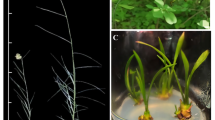Abstract
α-Tocopherol is the most biologically active component of vitamin E and is synthesized only by photosynthetic organisms. Two heterotrophic cell lines of sunflower (Helianthus annuus L.) of differing α-tocopherol biosynthetic capability, three-fold higher in the high synthesizing cell line, HT, than in the low synthesizing one, LT, were previously identified. To investigate the relationship between α-tocopherol biosynthesis and photomixotrophic culture conditions, a new photomixotrophic sunflower cell line HS3 was established by selecting HT cells able to grow in the presence of a ten-fold reduced sucrose concentration in the culture medium. The photosynthetic properties of HS3 cells were characterized in comparison with HT and LT cells, revealing an increase in chlorophyll content, chloroplast number, and level of the photosynthesis related enzyme ribulose-1,5-bisphosphate carboxylase/oxygenase (Rubisco). Furthermore, an enhanced expression of the gene encoding for the tocopherol biosynthetic enzyme geranyl-geranylpyrophosphate synthase (GGPPS) was observed in HS3 cells. HS3 cells also revealed a 25% and a more than three-fold higher tocopherol level than HT and LT, respectively, indicating a positive correlation between α-tocopherol biosynthesis of sunflower cell cultures and their photosynthetic properties. These findings can be useful for improving the tocopherol yields of the sunflower in vitro production system.




Similar content being viewed by others
References
Ajjawi I, Shintani D (2004) Engineered plants with elevated vitamin E: a nutraceutical success story. Trends Biotech 22:104–107
Bourgaud F, Gravot A, Milesi S, Gontier E (2001) Production of plant secondary metabolites: a historical perspective. Plant Sci 161:839–851
Bradford M (1976) A rapid and sensitive method for the quantitation of microgram quantities of protein utilizing the principle of protein-dye binding. Anal Biochem 72:248–254
Brigelius-Flohé R, Traber MG (1999) Vitamin E: function and metabolism. FASEB J 13:1145–1155
Caretto S, Paradiso A, D’Amico L, De Gara L (2002) Ascorbate and glutathione levels in two sunflower cell lines of differing α-tocopherol biosynthetic capability. Plant Physiol Biochem 40:509–513
Caretto S, Bray Speth E, Fachechi C, Gala R, Zacheo G, Giovinazzo G (2004) Enhancement of vitamin E production in sunflower cell cultures. Plant Cell Rep 23:174–179
Della Penna D (2005) A decade of progress in understanding vitamin E synthesis in plants. J Plant Physiol 162:729–737
Fischer U, Santore UJ, Hüsemann W, Barz W, Alfermann AW (1994) Semicontinuous cultivation of photoautotrophic cell suspension cultures in a 20 l airlift-reactor. Plant Cell Tissue Organ Cult 38:123–134
Fryer MJ (1992) The antioxidant effects of thylakoid vitamin E (α-tocopherol). Plant Cell Environ 15:381–392
Gala R, Mita G, Caretto S (2005) Improving α-tocopherol production in plant cell cultures. J Plant Physiol 162(7):782–784
Groß U, Gilles F, Bender L, Berghöfer P, Neumann KH (1993) The influence of sucrose and an elevated CO2 concentration on photosynthesis of photoautotrophic peanut (Arachis hypogaea L.) cell cultures. Plant Cell Tissue Organ Cult 31:143–150
Hofius D, Sonnewald U (2003) Vitamin E biosynthesis: biochemistry meets cell biology. Trends Plant Sci 8:6–8
Hosomi A, Arita M, Sato Y, Kiyose C, Ueda T, Igarashi O, Arai H, Inoue K (1997) Affinity for α-tocopherol transfer protein as a determinant of the biological activities of vitamin E analogs. FEBS Lett 409:105–108
Hüsemann W, Barz W (1977) Photautotrophic growth and photosyntesis in cell suspension cultures of Chenapodium rubrum. Physiol Plant 40:77–81
Kamal-Eldin A, Appelqvist LA (1996) The chemistry and antioxidant properties of tocopherols and tocotrienols. Lipids 31:671–701
Lichtenthaler HK, Prenzel U, Douce R, Joyard J (1981) Localization of prenylquinones in the envelope of spinach chloroplasts. Biochim Biophys Acta 641:99–105
Munnè Bosch S, Alegre L (2002) The function of tocopherols and tocotrienols in plants. Crit Rev Plant Sci 21:31–57
Munnè Bosch S, Falk J (2004) New insights into the function of tocopherols in plants. Planta 218:323–326
Nagatome H, Tsutsumi M, Kino-Oka M, Taya M (2000) Development and characterization of a photoautotrophic cell line of pak-bung hairy roots. J Biosci Bioeng 89:151–156
Oh SK, Kim IJ, Shin DH, Jang J, Kang H, Han KH (2000) Cloning, characterization, and heterologous expression of a functional geranylgeranyl pyrophosphate synthase from sunflower (Helianthus annuus L.). J Plant Physiol 157:535–542
Porra RJ, Thompson WA, Kriedemann PE (1989) Determination of accurate extinction coefficients and simultaneous equations for assaying chlorophylls a and b extracted with four different solvents: verification of the concentration of chlorophyll standards by atomic absorption spectroscopy. Biochim Biophys Acta 975:384–394
Schultz G, Soll J, Fiedler E, Schulze-Siebert D (1985) Synthesis of prenylquinones in chloroplasts. Physiol Plant 64:123–129
Sies H, Stahl W (1995) Vitamins E and C, β-carotene, and other carotenoids as antioxidants. Am J Clin Nutr 62:1315S–1321S
Soll J, Schultz G, Rudiger W, Benz J (1983) Hydrogenation of geranylgeraniol: two pathways exist in spinach chloroplasts. Plant Physiol 71:849–854
Traber MG, Sies H (1996) Vitamin E in humans: demand and delivery. Annu Rev Nutr 16:321–347
Yamada Y, Sato F, Hagimori M (1978) Photoautotrophism in green cultured cells. In: Thorpe TA (ed) Frontiers of plant tissue culture. University of Calgary, Calgary, Canada, pp 453–462
Widholm JM (1992) Properties and uses of photoautotrophic plant cell cultures. Int Rev Cytol 132:109–175
Acknowledgements
The authors are grateful to Prof. Laura De Gara and Dr. Giovanni Mita for the critical reading of the manuscript and helpful discussion. Thanks are due to Leone D’Amico for his technical assistance. This work was partially supported by Ministero dell’Università e della Ricerca Scientifica, project no. 7, cluster C05.
Author information
Authors and Affiliations
Corresponding author
Additional information
Communicated by M. Petersen
Rights and permissions
About this article
Cite this article
Fachechi, C., Nisi, R., Gala, R. et al. Tocopherol biosynthesis is enhanced in photomixotrophic sunflower cell cultures. Plant Cell Rep 26, 525–530 (2007). https://doi.org/10.1007/s00299-006-0268-5
Received:
Revised:
Accepted:
Published:
Issue Date:
DOI: https://doi.org/10.1007/s00299-006-0268-5




